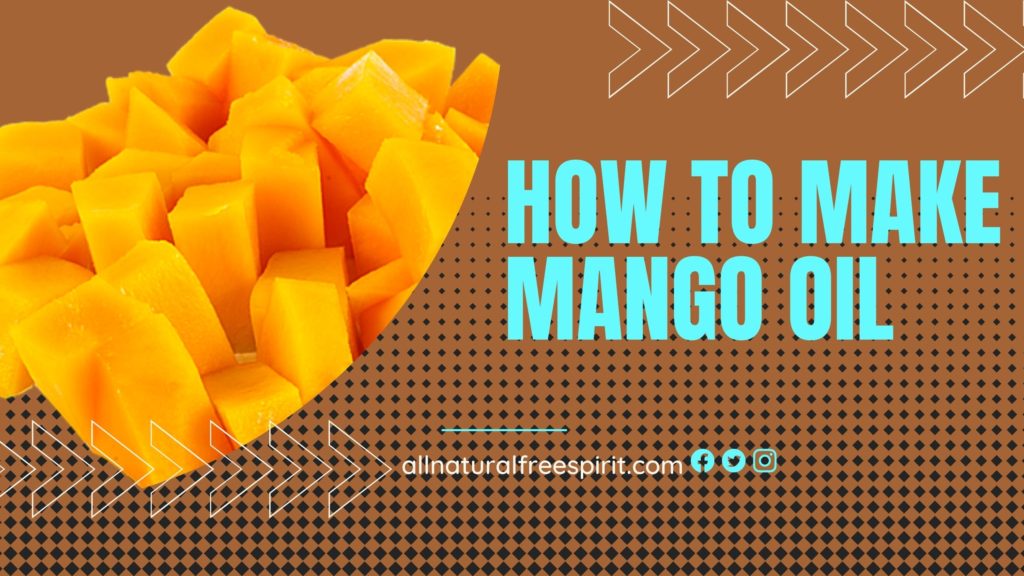Derived from the fleshy pulp inside the mango fruit, mango oil is a “volatile oil,” which means it will evaporate when exposed to air.
This makes it very useful for processing perfumes, cosmetics, and aromatherapy. To make mango oil at home, you will need a few simple ingredients that you can easily get in your kitchen.
Mango oil is said to have an effect similar to that of retinoic acid used in anti-wrinkle creams – it reduces the appearance of fine lines and scars.
It also acts as a natural moisturizer that can be used for dry or sensitive Skin.
Making your own mango butter oil is very simple and inexpensive, so learning how is a good idea. This blog post will show you step by step how to make mango oil while also explaining some of its benefits.
What is Mango Oil, and Where Does It Come From?

Mango Oil is an essential oil that has been used for centuries in traditional medicine. It has been reported to have anti-inflammatory, antioxidant, and antibacterial properties.
It is most commonly used in aromatherapy in the western world for its sweet, fruity scent. The oil’s aroma comes from myrcene and alpha-pinene, which are in large quantities.
Mango oil comes from a seed or kernel of a fruit called “Mangifera Indica,” which belongs to the Anacardiaceae family (which also contains poison ivy, poison oak, and poison sumac).
The chemical components vary depending on their process of production. The fruit is typically found in the tropical areas of Asia and Africa.
Mango oil is a skin-conditioning agent used in skin cleansing agents, toiletries, and cosmetics. It has a medium-heavy texture similar to olive oil.
One of the benefits of Mango Oil is that it is readily absorbed by the Skin, leaving no oily residue. It moisturizes the Skin without clogging pores while regulating the body’s natural oil production.
So how do you make this super amazing Oil?
Making Mango Oil: The Process
Over the years, Mango oil has been used as a homeopathic remedy, making it easy to find recipes to make your own at home.
This ester-rich oil has many therapeutic properties that can easily be added to your beauty routine.
You can typically extract this essential oil by steam distillation, but we will focus on an easier and less expensive way to get the same result.

Here is how to make mango oil :
Ingredients you will need:
- 1 cup of dried mango kernels (organic when possible)
- A large glass jar with a well-fitting lid or cheesecloth
- Olive Oil / Almond Oil or any other carrier oil
- 1 large pot for boiling water
- 2 large glass bowls or other heatproof containers to place in the pot with water
- A safe workspace where the Oil won’t spill
How To Make Mango Oil: Instructions
Step 1: Prepare Your Mango kernels
For this recipe, you will need around 3 to 4 mangos. Remove the mango seeds and dry them up using an oven or microwave. You may also dehydrate them using a food dehydrator if you have one available.
Once they are dry, Cut them up and remove the kernels inside. Keep in mind that at this point, there will still be a high water content inside the kernels, even though they are dry.
Grind them up into a fine powder using either a coffee grinder or food processor. You can also use a mortar and pestle if you want to do it by hand.
Step 2: Add Your Carrier Oils
Pour organic olive oil or your favorite carrier oil over the dried and powdered mango kernels until the oil completely covers them. The carrier oil is used to “carry” the essential oil and will help it dissolve into the water.
If necessary, add more carrier oil to make sure all of your mango kernels are covered by the essential oil. Place the lid on top securely, and give it a gentle shake.
Be sure to stir up the contents regularly to help dissolve any essential oil that might form on the top.
Step 3: Boil the Mango Kernel Solution
Pour 4 cups of water into your large pot and bring it to a gentle boil. Place the glass jar with the oils in it, as well as one of your heatproof containers inside.
Let the solution cook for 30 minutes or more. Keep stirring to ensure everything is well combined
Keep the solution submerged in the water until everything is well cooked. Monitor the water level every once in a while, so it doesn’t evaporate out.
Let your oil mixture simmer for about 30 minutes, stirring occasionally. Make sure the flame is low enough that it doesn’t burn off too much of the oil.
If you need to add more water, be sure to only fill it up to a quarter of an inch above the jar or container in order to prevent any accidents.
Step 4: Strain Your Oil
After about 30 minutes of simmering, turn off your stove and remove the jar of mango oil from the pot. Place a cheesecloth over top of another clean glass jar, and secure it with a rubber band.
Then use a funnel to transfer the contents from the glass jar into the cheesecloth-lined jar. Be careful not to burn yourself!
Extract your mango oil by squeezing or using a spoon to remove any excess pulp left in the cheesecloth.
Let your Mango Oil sit for around 15 minutes before transferring it to a storage container with an airtight lid. Keep this bottle out of direct sunlight.
Step 5: Bottle Your Oil
After you have strained out the mango kernel pulp, let the oil sit for a day to separate. The carrier oil will sink to the bottom and leave your concentrated essential oil floating on top.
Keep in mind that this does not have to be exact since you can always strain it again later.
Pour your oil into a clean glass jar, and place the lid on top securely to prevent any accidental spillage. Label your glass jar with the date and ingredients if necessary, and store it in a cool, dry place.
You can use your oil immediately or at a later time for whatever DIY recipes you have planned for it!
Step 6: Enjoy Your Mango Oil!
There are many different ways you can use this amazing oil. You can put some in a diffuser and enjoy the fragrance, or add it to your daily skincare routine for an extra boost of moisture.
Some people like putting it in their bathwater, massaging it into their scalp, or even using it as an edible oil for cooking.
If you plan on using your mango oil in a DIY recipe, be sure to add it after any water-based ingredients to preserve its moisturizing abilities.
Mango Oil can be used in DIY recipes such as:
Moisturizing and firming body butter, Creamy sugar scrub, Essential oil hair conditioner, Skin softening body wash, and many more!
The possibilities are endless with this amazing oil, get creative and have fun!
Mango Oil Benefits and Uses
This versatile essential oil has many benefits that can be used topically or internally.
- Mango Oil Emotional Benefits: – Helps to ease stress and anxiety while uplifting the mind.
- Mango Oil Physical Benefits: – It has been used for perfuming soaps, lotions, creams, and other commercial items. It is also a wonderful natural treatment for acne sufferers by reducing inflammation and regulating sebum production.
- Mango Oil Spiritual Benefits: – It is used for its cleansing properties, encouraging a healthy spiritual life.
Frequently Asked Questions about Mango Oil
Is Mango Oil Good For Hair?
Yes, it has a number of benefits for the hair. It restores moisture and softness while combating dandruff and scalp conditions. It is an excellent choice for both dry and oily hair.
Do You Need To Refrigerate Your Mango Oil?
That can depend on the carrier oil you are using. Usually, carrier oils have a longer shelf life than essential oils do. Check your carrier oil’s recommended shelf life, and use your best judgment.
Is Mango Oil An Essential Oil?
No, it is technically a carrier oil since most of its chemical composition is fatty acids. Like essential oils, though, it can be extracted from fruit, which makes it a fruit oil.
Mango oil is great for all sorts of applications, but you don’t need to break the bank to purchase it. While many organic mango oils can cost up to $40, you can make your own using simple ingredients that you can easily get!
That’s right! With this simple recipe on how to make mango oil, you can have your very own organic fruit oil that is safe to use with confidence. This essential oil is great for all sorts of uses, so be sure to remember it for your next DIY beauty recipe!

